
Inside our skull we have the most complex organ in the human body, the brain. Working like a command center for the nervous system, it processes information received from our senses and the body, then sends messages back to the muscles.
However, despite looking identical, the two hemispheres of the brain (linked by the corpus callosum) have very different functions:
A neuron or nerve cell is an electrically-excitable cell and one of the primary components of the nervous system. The human brain contains between 86 and 100 billion neurons.
Neurons are typically classified into three types based on their function:
Mirror neurons were discovered in the 1960s but it wasn’t until the 90s that we truly understood what they were for. We now know there is a link between ‘what we think’ and ‘what happens to us in life’ because we convey our thoughts and beliefs, either consciously (verbal and para-verbal) or unconsciously (non-verbal).
Attention enables us to process information and make decisions, but to be able to concentrate on something, we first need to know something about what we are perceiving. Concentrating in this context means choosing (unconsciously) what we want to perceive.
We are constantly triggering other people to have thoughts, feelings, emotions and reactions to who we are and what we do. We are also sending unconscious messages to the people around us and these produce positive or negative patterns, depending on our emotional state that help us create our reality. It’s as if we unwittingly pass on invisible viruses to other people that affects them and the reality we experience.
The words emotion, motivation and movement all have the same root, because they come from the Latin word motus meaning movement. Emotion is a movement that disturbs our body, whilst motivation means we want to move towards a goal.
Emotions trigger action, so desire pushes us forward whereas anger, aggression, distress and fear cause us to flee or freeze on the spot. But rage, fear and panic can lead to suffering, because we generate these three emotions in stressful situations or ones of excessive pressure.
When we feel trust and empathy, they produce oxytocin, also known as the love hormone. Under the influence of oxytocin, we are more generous, selfless and considerate of others. This hormone has a virtuous effect, with the more oxytocin we secrete, the more trusting we are so we secrete more oxytocin.
These four emotional circuits determine the choices we make. As a result, the better we understand our emotions, the more easily we can understand our decisions and actions.
If you would like to find out how Neuroscience can help you understand human behavior, check out our ebook in the online shop:
We constantly add content to the site, so please check our on-line shop and look at the full range of games, ebooks and kits. Or read some of the other blog posts written by our team of international coaches.
Image: Thanks to Karlis Reimanis for sharing their work on Unsplash.
Please note – Our blog post can only be shared if you link to this original source: (cc) MyCoachingToolkit.com – 2023